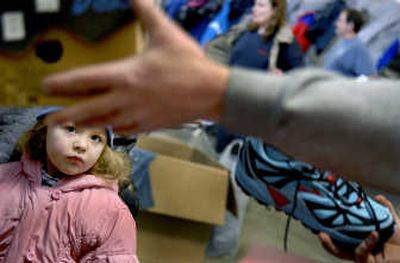Seeking shelter for homeless

Gary Breuchaud had been living out of his car for months in Seattle when a friend convinced him shortly after Christmas to move back to Coeur d’Alene and find help to beat his alcohol addiction.
Breuchaud returned but he didn’t know where he’d live until he met Rex Lettau at Real Life Ministries church.
Lettau and his wife, Luisa Lettau, invited Breuchaud to live in their Coeur d’Alene home. The Lettaus and their three boys open their home to as many as five homeless men and women at any given time, providing a roof over their heads, emotional support and a chance to get on their feet to make it on their own.
“This is an actual home. It’s nice and clean, and I have my own room and bed,” said Breuchaud as he ate lunch at the recent Homeless Connect event in Post Falls.
“They have a better chance because we treat them like family,” said Luisa Lettau. “We love them.”
North Idaho political leaders and social service providers geared up in recent weeks to help the homeless in the Panhandle with both short-term needs and the long-term goal of getting those with no shelter into safe, long-term housing.
About 60 volunteers fed, clothed and offered assistance to dozens on Jan. 31 at the “Homeless Connect” event at the Idaho National Guard Armory in Post Falls designed to connect homeless people with the social service providers who can help them. Other volunteers fanned out across the Panhandle earlier this month to count how many homeless live in Idaho’s five northern counties, and Coeur d’Alene leaders met to begin work developing a 10-year plan to end homelessness in the community.
Last year’s “point in time” survey of homeless in North Idaho found 341 people living in homeless shelters, in cars, in tents, on the street or in other unsheltered locations. The count found 1,749 homeless across the state.
At any given time about 150 homeless people are living in Coeur d’Alene and another 100 are living in Post Falls, said St. Vincent de Paul Transitional Housing Program Manager Matt Hutchinson.
The 10-year drive to end homelessness is being spearheaded by Coeur d’Alene City Councilman Mike Kennedy, who called together community leaders for the Feb. 1 meeting to start writing the plan to make it possible.
Kennedy said that ending homelessness in Coeur d’Alene in 10 years is an ambitious goal, but added that continuing to work on the issue without trying to end it doesn’t make sense.
“We don’t want to just manage homelessness. We need to end it,” Kennedy said.
Forty-five other Northwest communities have developed 10-year plans to end homelessness.
Several board members with Family Promise of North Idaho were at the meeting. The group is trying to raise money to launch its emergency shelter program in which a rotating line-up of volunteer churches open their doors to homeless families at night and feed them. During the day the kids go to school and a Family Promise case manager will help the parents find jobs and housing, said board member Lynne Downs.
The Lettaus’ decision to open their home to homeless men and give them enough time to find jobs and a place to live – even if it takes more than a year – is a different approach than traditional shelters that house men in dormitory style accommodations.
Long-term housing, especially permanent apartments and houses, works better in the long-run than emergency shelters do, said Paul Carlson, regional coordinator for U.S. Housing and Urban Development’s Interagency Council on Homelessness.
That “housing first” approach gives people the safe base they need to work on other issues including finding a job, education and treatment for addiction or mental health issues.
Providing homeless assistance is not just a matter or morality and caring, Carlson said.
“While compassion and a sense of justice play a role in it, and I know it does, the real factor has become cost,” he said.
Carlson explained that finding housing typically costs taxpayers $18,000 a year versus the $45,000 in services it costs to care for someone who is homeless.
Kennedy said it’s time for the effort to move beyond churches and social service groups and into the entire community, including businesses. “This is not a problem social service agencies alone can solve.”